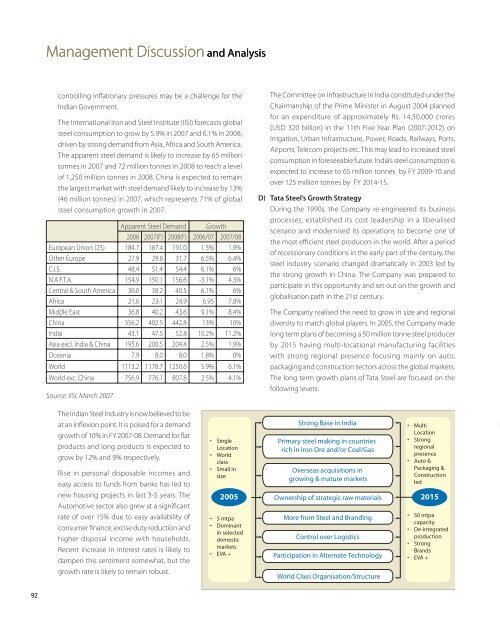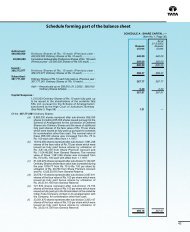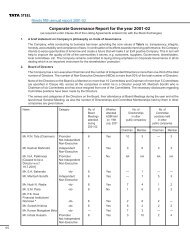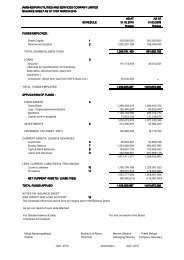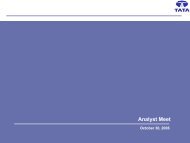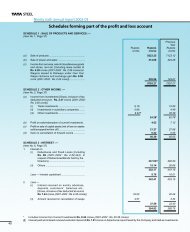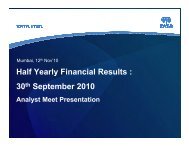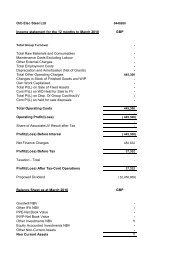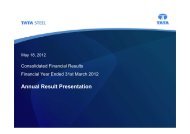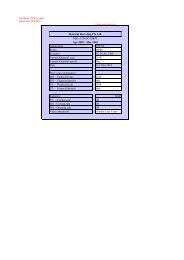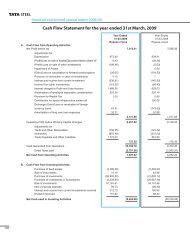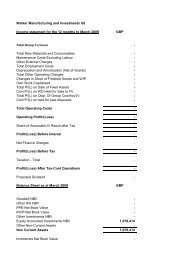100th Annual Report 2006-2007 - Tata Steel
100th Annual Report 2006-2007 - Tata Steel
100th Annual Report 2006-2007 - Tata Steel
You also want an ePaper? Increase the reach of your titles
YUMPU automatically turns print PDFs into web optimized ePapers that Google loves.
Management Discussion and Analysis<br />
controlling inflationary pressures may be a challenge for the<br />
Indian Government.<br />
The International Iron and <strong>Steel</strong> Institute (IISI) forecasts global<br />
steel consumption to grow by 5.9% in <strong>2007</strong> and 6.1% in 2008,<br />
driven by strong demand from Asia, Africa and South America.<br />
The apparent steel demand is likely to increase by 65 million<br />
tonnes in <strong>2007</strong> and 72 million tonnes in 2008 to reach a level<br />
of 1,250 million tonnes in 2008. China is expected to remain<br />
the largest market with steel demand likely to increase by 13%<br />
(46 million tonnes) in <strong>2007</strong>, which represents 71% of global<br />
steel consumption growth in <strong>2007</strong>.<br />
Apparent <strong>Steel</strong> Demand Growth<br />
<strong>2006</strong> <strong>2007</strong>(F) 2008(F) <strong>2006</strong>/07 <strong>2007</strong>/08<br />
European Union (25) 184.7 187.4 191.0 1.5% 1.9%<br />
Other Europe 27.9 29.8 31.7 6.5% 6.4%<br />
C.I.S. 48.4 51.4 54.4 6.1% 6%<br />
N.A.F.T.A. 154.9 150.1 156.6 -3.1% 4.3%<br />
Central & South America 36.0 38.2 40.5 6.1% 6%<br />
Africa 21.6 23.1 24.9 6.95 7.8%<br />
Middle East 36.8 40.2 43.6 9.1% 8.4%<br />
China 356.2 402.5 442.8 13% 10%<br />
India 43.1 47.5 52.8 10.2% 11.2%<br />
Asia excl. India & China 195.6 200.5 204.4 2.5% 1.9%<br />
Oceania 7.9 8.0 8.0 1.8% 0%<br />
World 1113.2 1178.7 1250.6 5.9% 6.1%<br />
World exc. China 756.9 776.1 807.8 2.5% 4.1%<br />
Source: IISI, March <strong>2007</strong><br />
The Committee on Infrastructure in India constituted under the<br />
Chairmanship of the Prime Minister in August 2004 planned<br />
for an expenditure of approximately Rs. 14,50,000 crores<br />
(USD 320 billion) in the 11th Five Year Plan (<strong>2007</strong>-2012) on<br />
Irrigation, Urban Infrastructure, Power, Roads, Railways, Ports,<br />
Airports, Telecom projects etc. This may lead to increased steel<br />
consumption in foreseeable future. India’s steel consumption is<br />
expected to increase to 65 million tonnes by FY 2009-10 and<br />
over 125 million tonnes by FY 2014-15.<br />
D) <strong>Tata</strong> <strong>Steel</strong>’s Growth Strategy<br />
During the 1990s, the Company re-engineered its business<br />
processes, established its cost leadership in a liberalised<br />
scenario and modernised its operations to become one of<br />
the most efficient steel producers in the world. After a period<br />
of recessionary conditions in the early part of the century, the<br />
steel industry scenario changed dramatically in 2003 led by<br />
the strong growth in China. The Company was prepared to<br />
participate in this opportunity and set out on the growth and<br />
globalisation path in the 21st century.<br />
The Company realised the need to grow in size and regional<br />
diversity to match global players. In 2005, the Company made<br />
long term plans of becoming a 50 million tonne steel producer<br />
by 2015 having multi-locational manufacturing facilities<br />
with strong regional presence focusing mainly on auto,<br />
packaging and construction sectors across the global markets.<br />
The long term growth plans of <strong>Tata</strong> <strong>Steel</strong> are focused on the<br />
following levers:<br />
The Indian <strong>Steel</strong> Industry is now believed to be<br />
at an inflexion point. It is poised for a demand<br />
growth of 10% in FY <strong>2007</strong>-08. Demand for flat<br />
products and long products is expected to<br />
grow by 12% and 9% respectively.<br />
Rise in personal disposable incomes and<br />
easy access to funds from banks has led to<br />
new housing projects in last 3-5 years. The<br />
Automotive sector also grew at a significant<br />
rate of over 15% due to easy availability of<br />
consumer finance, excise duty reduction and<br />
higher disposal income with households.<br />
Recent increase in interest rates is likely to<br />
dampen this sentiment somewhat, but the<br />
growth rate is likely to remain robust.<br />
• Single<br />
Location<br />
• World<br />
class<br />
• Small in<br />
size<br />
2005<br />
• 5 mtpa<br />
• Dominant<br />
in selected<br />
domestic<br />
markets<br />
• EVA +<br />
Strong Base in India<br />
Primary steel making in countries<br />
rich in Iron Ore and/or Coal/Gas<br />
Overseas acquisitions in<br />
growing & mature markets<br />
Ownership of strategic raw materials<br />
More from <strong>Steel</strong> and Branding<br />
Control over Logistics<br />
Participation in Alternate Technology<br />
World Class Organisation/Structure<br />
• Multi<br />
Location<br />
• Strong<br />
regional<br />
presence<br />
• Auto &<br />
Packaging &<br />
Construction<br />
led<br />
2015<br />
• 50 mtpa<br />
capacity<br />
• De-integrated<br />
production<br />
• Strong<br />
Brands<br />
• EVA +<br />
92


